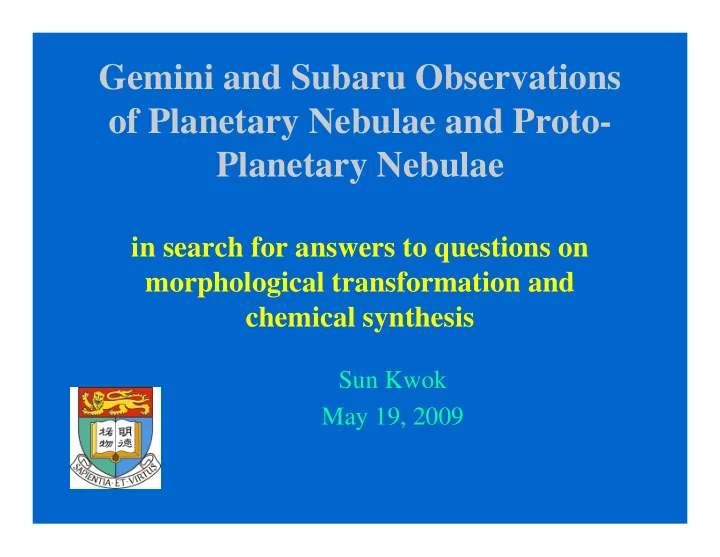

Gemini and Subaru Observations of Planetary Nebulae and Proto- Planetary Nebulae in search for answers to questions on morphological transformation and chemical synthesis Sun Kwok May 19, 2009
Origin of planetary nebulae • PN are the result of dynamical interaction between the remnant of the AGB wind and a newly developed fast wind • The interacting winds model has successfully predicted (i) the optical halo; (ii) fast wind (by IUE ); (iii) dust envelopes ( IRAS ); and the X-ray bubble ( ROSAT, Chandra )
Shells, Rims, Crowns, and Haloes NGC 5979 NGC 6578 NGC 2022 NGC 6629 NGC 5882 Multi-shell morphology can be explained by 1-D interacting winds dynamics
Morphological transformation to Bipolar Nebulae NGC 6302 Confined by dust torus? NGC 2346 Many well-known PN, such as the Eastern lobe Ring, the Dumbbell, the Owl, the Eskikmo, NGC 7027, are bipolars.
IC 4406 H 2
Ionized (10 4 -10 6 K), molecular (10 1 - 10 2 K) and dust (10 2 K) components 10000 BD +30 ° 3639 1000 Flux (10 -10 erg s -1 cm -2 ) 100 Dust continuum 10 b-f continuum 1 0 0 1 10 100 Wavelength ( µ m)
Spitzer MIPS imaging of the dust components Warm dust in lobes NGC 2346 torus AGB remnant Su et al. 2004
Mid-IR imaging of dust torus Hen 3-401 T-ReCS at Gemini South ( 10.36, 10.38, 11.66, 12.33, 18.30, 24.56 µm ) Most of the fluxes emitted >30 µm, so at 20 µm we are still seeing warm dust Subtraction of the 10.38 µm image from the 11.66 µm Muthu et al. 2006 image gives the distribution of the 11.3 µm AIB feature.
Shaping occurs early, in the PPN stage The The Cotton Silkworm Candy Nebula Nebula The Walnut Nebula The Water The Spindle Nebula Lily Nebula
Dust in the torus and in the lobes Edge-on torus IRAS 16594-4656, the Water Lily Nebula T-ReCS, Gemini South Closed lobes, fast wind yet to break through
HST WFPC2 I band: all scattered light HST NICMOS H 2 Confined by very low temperature dust
Imaging of edge-on torus in PPN After deconvolution IRAS 17441-2411, the Silkworm Nebula Volk and Kwok (2007)
Equatorial disk as collimating agent HST I-band image Misaligned by 23 degrees! A precessing outflow?
Multipolar Nebula Gemini T-ReCS NGC 6881 (HST [NII], Kwok & Su 2005)
Synthesis of complex organic compounds in post-AGB evolution • AGB: over 60 gas-phase molecules including chains and rings • Late AGB (extreme carbon stars): acetylene • PPN: aromatics and aliphatics • PN: strong aromatics Kwok, Volk & Hrivank 1999, A&A, 350, L35; Kwok, Volk, & Bernath 2001, ApJ, 554, L87; Kwok 2004, Nature, 430, 985; Kwok 2009, ApSS, 319, 5
Aromatic Infrared Bands 1500 [NeIII] [SiIV] [NeV] NGC 7027 11.3 12.7 λ F λ (10 -10 erg cm -2 s -1 ) 1000 13.5 12.0 Gemini OSCIR 7.7 8.6 [MgV] 500 6.2 3.3: sp 2 C-H stretch 6.2: sp 2 C=C stretch 7.7: sp 2 C-C stretch 8.6: sp 2 =C-H in-plane bend 3.3 11.3: sp 2 =C-H out-of-plane bend 0 0 2 4 6 8 10 12 14 16 18 20 Wavelength ( µ m)
Aromatic and aliphatic features in PPN
Observational confirmation of the chemical synthesis history • When do the carriers of the AIB form? • When do the transformation from aliphatics to aromatics occur? • Narrow-band imaging (Kwok et al. 2001) • Imaging spectroscopy (Goto et al. 2007)
Aliphatic sidegroups 8.0 3.29 21282+5050 7.0 Keck NIRSPEC λ F λ (10 -10 erg cm -2 s -1 ) 3.29: aromatic C-H stretch 6.0 3.40: asym. CH 2 , CH 3 3.46: lone C-H group 5.0 3.4 3.51: symmetric CH 2 3.56: aldehydes C-H stretch 3.462 4.0 3.515 3.56 3.0 2.0 1.0 3.0 3.1 3.2 3.3 3.4 3.5 3.6 3.7 3.8 3.9 4.0 Wavelength ( µ m)
Diffraction-limited 3-µm spectroscopy Subaru IR Camera & Spectrograph with AO 05341: unresolved, 04296: 400-640 AU, 22272: extends to 2000 AU 100-160 mas Goto et al. 2007
Summary • High-resolution mid-IR imaging can map out the distribution of “dark matter” in PN and help understand the origin of bipolar/multipolar morphology • Imaging spectroscopy can map the distribution of aromatic/aliphatic organics and help understand the formation of these species
Recommend
More recommend